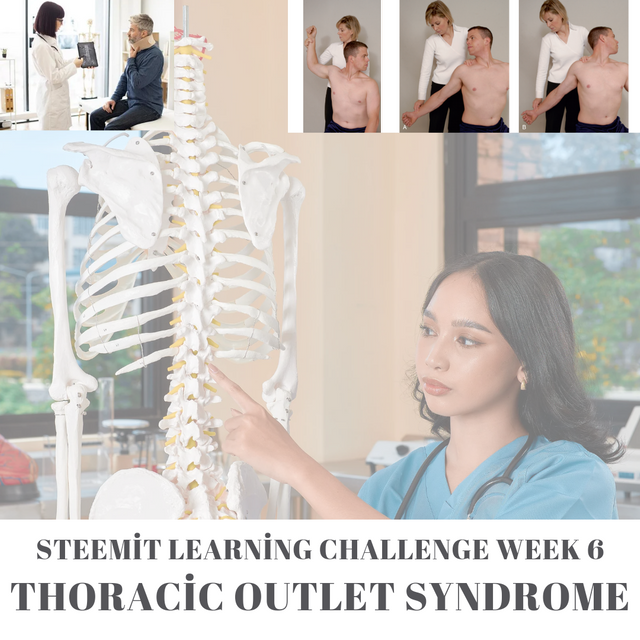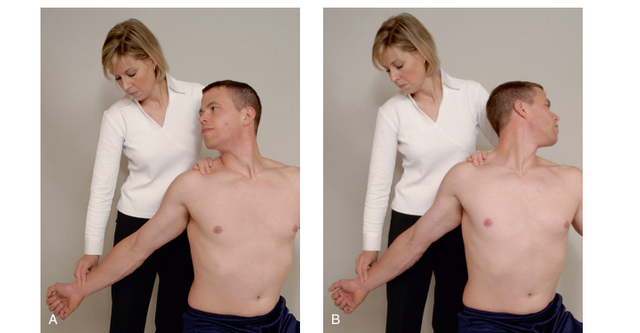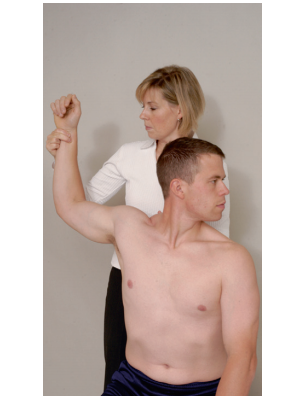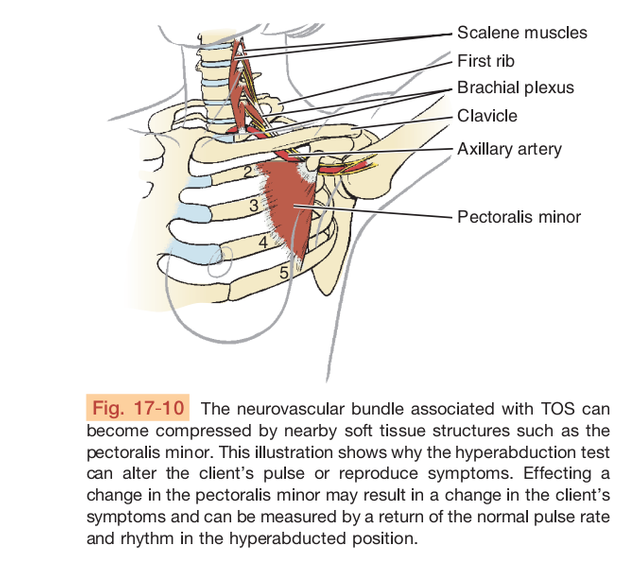Steemit Learning Challenge-S22W6: Physical Therapy Intervention: Thoracic Outlet Syndrome
Hello, everyone; we are here to share the contest for week 6 and final week, Steemit Learning Challenge season 22. I am grateful to all the users who participated in the previous week and supported my course, and thankful to the Steemit team for this opportunity. I invite all the users to share their unique participation and try to gain maximum grades to get selected as the winner of the Steemit Engagement Challenge season 22, week 6.

Thoracic Outlet Syndrome (TOS)
Thoracic Outlet Syndrome is the compression of the nerves or vascular structures that passes or leave through or over the superior rim of thoracic cage. It's known by other names as well on the basis of site involve or neurovascular compression like First Thoracic Rib, Cervical Rib, Hyper abduction syndromes, costoclavicular.
The patient arrived with past medical history anatomic anomalies like of extra rib or unusual sternoclavicular and other reasons. The anatomical structures where this syndrome can occur are brachial plexus (nerves that control arm & hand functions), scalene muscles ( muscles around the neck region), subclavian artery & vein that supply blood to upper region like neck, shoulder and thoracic.
Causes
The common causes of TOS are below:
- Occupational activities like overhead activities while carrying heavy load, repetitive arm movements.
- Poor posture for example sleeping with arms elevated overhead.
- Acute Trauma or injuries like whiplash injury that occur in RTA ( road traffic accident) due to hyperflexion or hyperextension of cervical region.
- It can also occur in some sport activities like in swimmers, volleyball, baseball etc.
- History of such injuries in past & occur again
- Compression of any structures that are around neck and shoulder region.
Symptoms
The common symptoms shown in TOS patients are categorized as vascular and neuropathic sign & symptoms.
Vascular
- Bluish hand appearance due to abnormal blood flow or supply to hand or arm especially in overhead activities.
- Cold & heaviness in arm & hands while performing exercises as blood supply compromised in extremities.
- Throbbing type pain in chest, neck, arm and hand.
- Puffiness or swelling sometimes in axilla, arm, clavicle, or hand region.
- Fatigue and weakness in the upper extremity
Neuropathic
- Tingling and numbness sensation in medial side or ulnar nerve distribution pattern.
- Muscle wasting or atrophy in hand, difficulty in performing the fine motor activities.
- Pain in the ulnar nerve distribution patter.
Types of Thoracic Outlet Syndrome
There are 3 types of TOS based on the structures involvement.
- Vascular TOS: this is the type in which vascular structures involved like subclavian artery and vein that comprised the blood supply to neck, arm and hand.
- Neurogenic TOS: this is the type in which nerves involve of brachial plexus like most commonly ulnar nerve and others too that causes tingling, numbness sensation in shoulder, axilla, arm and hand.
- Mixed TOS: this is the type in which neurovascular structures involved both nerves and blood vessels. Or combination of vascular and neurogenic type of TOS.
Diagnosis
TOS diagnosis can be made by different methods, but commonly used are:
- History taking about family, occupation, past medical, and surgical history.
- A thorough physical examination by a physician or physical therapist.
- X-ray, Ultrasound and MRI to assess arthritis, any tendon ruptures, and muscle damage, respectively.
- We will also perform EMG & NCS to assess the nerve damage and muscle strength.
Special Tests
In physiotherapy, we perform some special tests to confirm the diagnosis.
 |  |
|---|---|
| Adson & Halstead maneuver | Allen/Wright test |
- Adson Maneuver
- This is the test performed by patient in sitting position, arm at his/her side, face forward, measure the BP before performing test, the ask patient to turn head/neck, head and neck are in extended position. Ask patient to deep breath or hold the breath of symptoms reproduce then test is positive.
- Halstead Maneuver
- This is the test performed by patient in sitting position, measure the radial pulse before test, making the above test position just rotates head to opposite side, the therapist applies a downward and traction force site involved. Assess the radial pulse if there is change in rhythm then vascular TOS is positive.
- Allen or Weight Test
- This test is performed on patient in sitting position, hyperabduction at shoulder joint. Observe the changes in skin color, temperate, also radial pulse to see any changes in rhythm.
Physical Therapy Intervention for Thoracic Outlet Syndrome
Physical therapy interventions for Thoracic Outlet Syndrome for days to weeks to regain normal range of motion or performing activities of daily living, and subside the symptoms. Here are a few exercise videos that you have to perform to treat Thoracic Outlet Syndrome patients. Treatment protocols vary from patient to patient.
But the main thing is you have to evaluate the exact cause of a Thoracic Outlet Syndrome and its stage types as well because treatment protocol varies from stage to stage, whether it's due to overuse or trauma. We can treat this condition completely with physical therapy, but sometimes surgical intervention is required if further damage occurs to spine.
Shoulder Shrugs
Shoulder shrugging the exercise necessary to improve the posture, relieve tension of shoulder, strengthen the trapezoius muscles, and improve scapula mobility. Always perform this exercise whenever you feel weakness or heaviness in the shoulder region.
Scapula Retraction
Scalene are deep muscles of neck, also rhomboids too for their strengthening and stretching shoulder retraction plays important role to improve that. Also if you have upper back then shoulder retraction is the best exercise.
Shoulder External Rotation
Whenever there is shoulder and neck muscles involvement, there is limited ROM of shoulder and neck. External Rotation is necessary in completion of ADL's and to strengthen the muscles around axillary region.
Straight Arm Shoulder Extension
Most of the times in thoracic outlet syndrome, shoulder ROM reduce especially extension due to muscle weakness or vascular involvement. So, for improve shoulder extension ROM this exercise is perform either band or fabric for better extension & muscle stretch.
Apply a heat therapy for 5 to 10 minutes to reduce pain and relax muscles. Also, do soft tissue mobilization before performing these exercises to reduce pain. Perform 5, 5 repetitions on the first week, then increase accordingly. These are the exercises for beginners, as other exercises can be performed by professionals and experienced physiotherapists or gym trainers.
- What's a thoracic outlet syndrome? Write in your own words after getting knowledge from the lesson post. (Note: don't add special tests or investigations and detailed treatment in this question. Write the answer precisely).
- How would you diagnose a thoracic outlet syndrome? Any clinical investigation or assessment tests? ( Don't add treatment to this question)
- Try to practice at least 3 exercises that you have learned from the lesson. Share images, gifs or videos while practicing preferably gifs or videos.
- Share your review after performing these exercises either on yourself, a healthy individual or a patient.

You are free to post in any community.
All country members are allowed. You can write your post in any language.
- Plagiarism will not be supported. Content should be free of AI. (Content must be steemexclusive).The Title of the Post should be Steemit Learning Challenge-S22W6; Thoracic Outlet Syndrome"
The tags are #pti-s22w6 (the main tag must be used in your post), #tos, and #physicaltherapy; others tags are like your country as Pakistan, club status as club100, and #steemexclusive.
Try to use your pictures, videos or git to represent homework tasks.
Mention my username @ashkhan in your participation post.
Invite your 3 friends to participate in our contest. Upvote and Redeem the contest post so that more users participate in this and upvote.
Share your participation link under the comment section of this post.
Share your post on Twitter by adding a little information about your post and a specific hashtag like physiotherapy, and share the link in your post comment section.
Contest will start at 00:00 (UTC) on Monday, 20th January, and end at 23:59 (UTC) on Sunday, 26th January 2025.
Subscribe to Steem Physio & Rehab to share your physical therapy related content there.
Reward
All 4 winners post will be rewarded by Sc01/Sc02.
Each week we would like all Teaching Teams to make a post announcing the 4 people who have produced the best responses to the assignments and challenges. The selection of the 4 should be based solely on the quality of their post. Number of comments is no longer a factor to be considered.
Cc,
@pennsif
@disconnect

Feliz y bendecido día @ashkhan. Aquí dejo mi participación
https://steemit.com/pti-s22w6/@zulay7059/steemit-learning-challenge-s22w6-thoracic-outlet-syndrome
Esta publicación fue promociónnada en Twitter
https://x.com/zulyromerog/status/1882892632277524604?t=nXN7ygO4Xm_EkY3AcSUNvQ&s=19
My entry : https://steemit.com/hive-103393/@walictd/steemit-learning-challenge-s22w6-thoracic-outlet-syndrome
https://steemit.com/hive-118902/@xkool24/steemit-learning-challenge-s22w6-thoracic-outlet-syndrome
My entry: https://steemit.com/pti-s22w6/@jyoti-thelight/steemit-learning-challenge-s22w6-thoracic-outlet-syndrome
My entry:
https://steemit.com/hive-127432/@emishael60/steemit-learning-challenge-s22w6-thoracic-outlet-syndrome
https://steemit.com/burnsteem25/@sahar78/steemit-learning-challenge-s22w6-thoracic-outlet-syndrome
My entry : https://steemit.com/hive-153970/@cymolan/steemit-learning-challenge-s22w6-thoracic-outlet-syndrome
https://steemit.com/pti-s22w6/@drhira/steemit-learning-challenge-s22w6-physical-therapy-intervention-thoracic-outlet-syndrome
My entry
https://steemit.com/hive-127432/@rossnenye/steemit-learning-challenge-s22w6-thoracic-outlet-syndrome-by-rossnenye
¡Holaaa amiga!🤗
Por acá te comparto mi participación en la dinámica: https://steemit.com/pti-s22w6/@paholags/steemit-learning-challenge-s22w6-sindrome-del-desfiladero-toracico